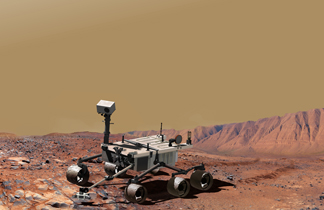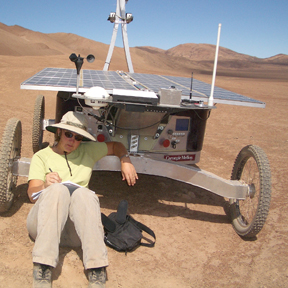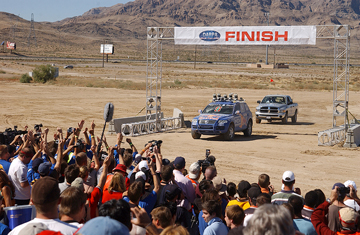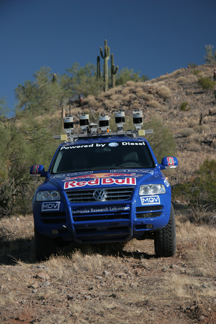|
Feature
Revolutionary Robotic Explorers
Megan Sever
Next-gen Mars rovers Print Exclusive
Robotic race
 In
the spring of 2004, 15 robotic vehicles set out from Barstow, Calif.,
en route across the Mojave Desert to Primm, Nev., outside of Las Vegas,
in a 142-mile (228-kilometer) race. The Grand Challenge
race was designed to test the capability of autonomous vehicles to drive
significant distances in an obstacle-laden course. Not one vehicle made
it farther than 8 miles. A year and a half later, 23 vehicles began a
similar race on a similar course, beginning and ending in Primm. This
time, though, four vehicles completed the more-difficult course in fewer
than 10 hours. “Stanley,” a souped-up
Volkswagen Touareg, won the race and took home the $2 million purse and
bragging rights.
In
the spring of 2004, 15 robotic vehicles set out from Barstow, Calif.,
en route across the Mojave Desert to Primm, Nev., outside of Las Vegas,
in a 142-mile (228-kilometer) race. The Grand Challenge
race was designed to test the capability of autonomous vehicles to drive
significant distances in an obstacle-laden course. Not one vehicle made
it farther than 8 miles. A year and a half later, 23 vehicles began a
similar race on a similar course, beginning and ending in Primm. This
time, though, four vehicles completed the more-difficult course in fewer
than 10 hours. “Stanley,” a souped-up
Volkswagen Touareg, won the race and took home the $2 million purse and
bragging rights.
Scientists are designing future Mars rovers, such as the Mars Science Laboratory rover illustrated here, to be stronger and faster, and to do more scientific research, than the two rovers currently traversing Mars. Researchers plan to launch the new rover in the fall of 2009. Image is courtesy of NASA/JPL-Caltech.
The Defense Advanced Research Projects Agency (DARPA), the research and development arm of the Department of Defense, created the challenge following a 2001 congressional mandate that one-third of the armed forces’ “operational ground combat vehicles” be autonomous by 2015, says Jan Walker, a DARPA spokeswoman. The goal of the challenge, she says, was to energize the private sector and academia into getting involved in developing autonomous ground vehicles that could help save lives on the battlefield. Although DARPA’s focus is the development of autonomous vehicles for military use, she says, such technologies can reach much further than the battlefield, perhaps as far as space.
From fiction to fact
Robots today are going further than ever in exploring new territory, both
physically and technologically. They are “intelligent” machines
that function with minimal direction from humans, and are similar to those
envisioned in early science fiction, conjuring up images of the famed
R2-D2 in Star Wars.
Much of the current research in robotics revolves around exploration, says David Wettergreen, a roboticist at Carnegie Mellon University in Pittsburgh, Pa. “We’re working on rovers that can explore active volcanoes, the high Arctic, underwater, and other planets and moons, especially those with terrestrial analogs,” Wettergreen says. These autonomous vehicles have the ability to go into extreme environments, collect data, and understand and process the information to make more effective exploration decisions, he says.
“Robots can go places where it is too dangerous, expensive, monotonous or even inaccessible for a person” to go, such as a battlefield or an erupting volcano, says Gabe Hoffmann, a graduate student in the department of aeronautics and astronautics at Stanford University in Palo Alto, Calif., who was on the team that developed Stanley, the vehicle that won the DARPA challenge. Robots can go to Mars and beyond, which humans cannot do yet. Furthermore, it is extremely expensive to support a human in space, and losing a robot is vastly preferable to losing a soldier or a volcanologist, he says.
“On the other hand, humans are capable of rapid response to changing conditions,” Hoffmann says. It is difficult for a robot to “determine the right questions to ask in any situation in order to adapt to its surroundings and exploit what it knows.”
Indeed, “as sophisticated as our rovers are, things humans take for granted, like picking up a rock or chipping off a corner with a rock hammer, are still challenging” for robots, says Richard Welch, deputy systems engineer for the Mars Science Laboratory (MSL) at NASA’s Jet Propulsion Laboratory in Pasadena, Calif. Robots will never completely replace people, but “right now, robotic explorers are the only game in town,” he says, and they can greatly increase our understanding of foreign planets and places.
While some research technologies, such as the autonomous vehicles built for the DARPA challenge, focus on higher speed and GPS-based navigational systems to drive over rough terrain for military uses, Wettergreen is more interested in auto-nomous vehicles designed for scientific missions. He heads a project at Carnegie Mellon called Life in the Atacama, to test robots in the Chilean desert as an analog for future space missions. The rovers being tested “can’t go down a dirt road at 50 miles per hour like the DARPA vehicles because we don’t have roads where we’re going,” but they can act like robotic geologists, observing the environment around them as they travel.
Some of the technical details from the military-oriented vehicles, including obstacle avoidance, are similar. “There’s definitely crossover” among technologies developed for the military and for exploration purposes, Hoffmann says.
Regardless of their application, the robots need to be able to interpret their environment, Hoffmann says. Most of the robots use laser scanners and stereo cameras as “eyes,” GPS devices or the like for guidance, specially designed sensors for interpreting data, and some form of artificial intelligence for making independent decisions.
Roving Mars
Since January 2004, the Mars Exploration Rover (MER) mission’s two
intrepid rovers, Spirit and Opportunity, have been traversing the terrain
of the red planet, sending back data on what they find. NASA is using
the rovers, which have already found what many say is evidence of past
water, to figure out whether life ever existed on Mars, or whether the
planet could have ever sustained life (see Geotimes,
February 2006). NASA hopes that the next generation of rovers will
prove ever more useful in this endeavor. The new Mars rover mission, MSL,
is being planned for launch in the fall of 2009, with a landing on the
planet in summer 2010, Welch says. Welch and his team are developing the
new rovers, which will be state-of-the-art autonomous explorers.
These rovers will be looking for conditions for life, such as water, hotspots and energy sources other than sunlight. They will also be looking for telltale signs of life on Mars, such as carbon, as well as characterizing the planet’s climate and geology, in preparation for eventual human exploration.
At about the size of a Mini Cooper (though taller), the new rovers will be bigger and four times heavier than Spirit and Opportunity, which are both about golf-cart-sized, Welch says. Furthermore, the MSL rovers will carry 10 scientific instruments, instead of the five that are on the MER rovers, and the new robots will be able to analyze rock samples rather than just observe what they see. The MSL rovers will collect martian soil samples and rock cores, crush and grind up the samples, and analyze them for organic compounds and environmental conditions that could have supported microbial life now or in the past. The new rovers will also be able to drive faster and go over larger obstacles, allowing them to cover more ground than the old rovers did.
Additionally, while Spirit and Opportunity run off of solar energy, researchers are considering powering the MSL rovers with nuclear energy, which would enable the rovers to go to darker and colder places than Spirit and Opportunity can reach, such as the martian poles, or deep into craters, Welch says. The MSL rovers will be able to cover three-quarters of Mars’ surface — 10 times more ground than Spirit and Opportunity have covered.
The old and new systems will work similarly in their communications in that every morning and evening, “we’ll talk to the rovers,” Welch says. Scientists on the ground will download the rovers’ data and analyses each evening, and send the rovers a new game plan for the day every morning. The scientists are only involved to the extent that they will tell the rovers to go in a particular direction in the morning. “The rest is up to the rovers,” he says.
Desert test
The new martian rovers will work in almost exactly the same way as those
Wettergreen is operating in the Atacama Desert in Chile. Indeed, some
of the instruments that may be deployed on the MSL rovers are currently
being tested on Zoë, the rover that has traversed the Atacama over
the past three years.
The Atacama has long been considered an analog for Mars, being one of the most extreme places on Earth. No plants or animals exist there, nor any other visible evidence of life; almost no precipitation falls there; and solar radiation is among the highest anywhere on this planet. Yet life does exist in the desert, in the form of microbes, similar to what some researchers think may be lurking — or the remnants of such — on Mars or other spatial bodies. So researchers from NASA and Carnegie Mellon have been using Zoë to look at the distribution of microbes in the desert, Wettergreen says.
Like the MSL rovers, Zoë has a wide field of view using high-resolution stereo cameras that can record close-up images as well as horizons, Wettergreen says. Both Zoë and the MSL rovers have an infrared spectrometer, designed to analyze and quantify mineralogical content in soils and rocks, as well as a fluorescence imager, which is designed to detect signs of life, such as chlorophyll, carbohydrates and DNA. The rovers also include meteorological stations to measure humidity, temperatures, winds and ultraviolet radiation and, of course, the tools to record, analyze and communicate any findings.
 “We’re
also trying to add in another aspect of intelligence — the ability
of the robotic explorer to see something outlying or interesting and to
pursue it, identify it and examine it,” Wettergreen says. But, he
says, that may take a bit of time to develop.
“We’re
also trying to add in another aspect of intelligence — the ability
of the robotic explorer to see something outlying or interesting and to
pursue it, identify it and examine it,” Wettergreen says. But, he
says, that may take a bit of time to develop.
For the past three years, a rover named Zoë, pictured here with one of its human colleagues, has been exploring the Atacama Desert in Chile, thought to be a good analog for Mars. Zoë has been helping researchers learn how to best design rovers for space exploration. Image is courtesy of the Life in the Atacama project.
In fact, several next-generation technologies may take some time, partially because the computer programs to run the artificial intelligence aspect of the robots need to be developed, but also because of funding issues for programs such as NASA’s Astrobiology Institute, which helps fund Zoë’s exploration, Wettergreen says (see Geotimes, June 2006). Developing the technical capabilities of these robots, he notes, takes a tremendous amount of time, effort and funding.
Still, the current work in the Atacama and elsewhere is laying the groundwork for future robotic exploration. “The study of life in the Atacama is interesting in and of itself — where life exists in the desert and why it’s distributed the way it is, how soil properties or sun angles or altitudes affect distribution, for example,” Wettergreen says. “But understanding that helps us look for analogs elsewhere on Earth, which in turn helps us understand where to look for life on Mars,” he says.
Most of the present-day robotic missions — from the DARPA Grand Challenge to Life in the Atacama — will further the development of future exploration rovers, Hoffmann says. Stanley, Zoë, and the martian rovers, he says, are all looking at the universe through fresh, robotic eyes.
|
Robotic
race Stanley, a souped-up Volkswagen Touareg adapted by a Stanford University team, crossed the finish line in the Mojave Desert in the 2005 DARPA Grand Challenge faster than any other robotic vehicle. Photo is courtesy of DARPA Grand Challenge. To encourage development of unmanned vehicles, DARPA sponsored a race across the Mojave Desert called the Grand Challenge, which ran in both 2004 and 2005 (see main story). “We were trying to hold a field demonstration of autonomous ground vehicle technologies to show that these vehicles were capable of traveling long distances over rough terrain at tactically relevant speeds,” Walker says. They chose the Mojave because “it is similar to what our forces are experiencing in Iraq,” she says. In 2004, no vehicles finished the race. In 2005, four crossed the finish line in fewer than 10 hours, which was the goal. They averaged 17 to 19 miles per hour (about 29 kilometers per hour). The winning vehicle, “Stanley,” a Volkswagen Touareg adapted by a Stanford University team, took home the $2 million prize. The 2005 course was set up with certain straightaway sections where vehicles could go faster, and other sections where they had to slow down or stop, such as mountain switchbacks or tunnels. The vehicles encountered natural obstacles, narrow underpasses and rough roads the whole way, Walker says. Each vehicle had to complete a qualifying course in the days before the Grand Challenge. Two hours before the race began, DARPA gave the teams — varying groups of academics, industry leaders, community groups and students — GPS coordinates, or waypoints, for the race course, which the teams then uploaded to their vehicles. The rough GPS coordinates work as a “sort-of roadmap, only guaranteeing that there’s a passable route — there could be cliffs, other vehicles, tank traps and the like in there that the vehicles have to pass by safely,” says Gabe Hoffmann, a graduate student who was a member of the Stanford team.
A team at Carnegie Mellon University, for example, whose two vehicles came in second and third place in the race, used high-resolution satellite data and the GPS coordinates to manually “preplan” the race to give their vehicles the best chances, Hoffmann says. Hand-picking the route improves safety and minimizes risk to the vehicle. Stanley the Touareg, an artificially intelligent robotically driven SUV, raced across the Mojave Desert in October 2005, winning the DARPA Grand Challenge. Photo is courtesy of Stanford University. The Stanford team relied almost entirely on artificial intelligence, Hoffmann says: “Our goal was to let Stanley do it himself.” Stanley figured out for itself what obstacles it could go over and which it needed to go around. The team figured in the long-run, he says, that it was more helpful to have a vehicle that could “think” independently, for use in the military and for other applications, such as robotic space exploration. DARPA is now accepting applications for its 2007 Grand Challenge, which will be a 60-mile-long (97-kilometer-long) urban course, where vehicles will have to navigate through traffic lights, circles and busy intersections and avoid obstacles, while obeying traffic laws, in less than six hours. “We recognize the need for autonomous vehicles to be able to navigate in traffic, as most supply missions — as well as other missions — aren’t likely to start in the middle of nowhere and end there,” Walker says. The team to finish the race in the shortest amount of time will win the $2 million. MS |
Sever is a staff writer for Geotimes.
Links:
"No lake on Mars?"
Geotimes, February 2006
"NASA: The Sick Man of Federal Research,"
Geotimes, June 2006
DARPA
Grand Challenge
NASA/JPL
Mars Science Laboratory
NASA/JPL
Mars Exploration Rovers
Life
in the Atacama project
Stanford
Racing

 Subscribe
Subscribe

 By
2015, one-third of all ground vehicles used by the military must
be autonomous. While the military is already using some unmanned
vehicles in Iraq and Afghanistan, they’re hoping to incorporate
them much more into the future, for particularly “dull, dirty
or dangerous” missions, says Jan Walker, spokeswoman for the
Defense Advanced Research Projects Agency (DARPA), the research
and development arm for the Department of Defense. Such missions
could include surveillance and reconnaissance, mine and ordinance
clearing, communications, and carrying supplies, she says.
By
2015, one-third of all ground vehicles used by the military must
be autonomous. While the military is already using some unmanned
vehicles in Iraq and Afghanistan, they’re hoping to incorporate
them much more into the future, for particularly “dull, dirty
or dangerous” missions, says Jan Walker, spokeswoman for the
Defense Advanced Research Projects Agency (DARPA), the research
and development arm for the Department of Defense. Such missions
could include surveillance and reconnaissance, mine and ordinance
clearing, communications, and carrying supplies, she says.  Teams
took two approaches, Hoffmann says. One option involved a vehicle
that relied entirely on artificial intelligence, and one did not;
both were autonomous, or operated on their own.
Teams
took two approaches, Hoffmann says. One option involved a vehicle
that relied entirely on artificial intelligence, and one did not;
both were autonomous, or operated on their own. 